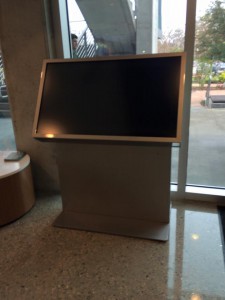
When students returned to campus from winter break, six kiosks had been installed. No one seemed to know what they were for.
The kiosks aren’t as mysterious as they seemed. They are a part of the first steps in a push toward a more sustainable campus. The kiosks will allow students to track how much energy USF St. Petersburg is using.
Spearheading the project is sustainability coordinator Jennifer Winter.
The kiosks work similarly to that of a touchscreen computer. They give real-time energy statistics, along with more sustainable information about USFSP.
The kiosks will be able to record the energy the parking garage, which has been retrofitted with a Tesla battery storage system and a Sunsense PV solar array of panels, uses. The wall-mounted kiosk was provided by manufacturer Lucid.
What caught many students and staff off guard was the appearance of another five standing monitor kiosks. The other five kiosks were donated by Duke Energy, the company which provided the grant for the solar panels. These five kiosks have been stationed in the University Student Center, the Student Life Center, Bayboro Hall, the Nelson Poynter Library and Harbor Hall.
The parking garage will be the only building monitored by the kiosk.
Winter believes there are going to be numerous benefits to bringing this technology to USFSP.
By having that monitoring system, there is a one to two percent decrease in energy usage just by change in behavior, Winter said.
The statistics will be saved in cloud storage and can be tracked from year to year. There are also plans to have energy competitions between buildings, residence halls and even from floor to floor, Winter said.
Winter noted that 12 professors have showed interest in intertwining the data from the kiosks with their curriculum.
Like the parking garage, the Lucid kiosk was bought with grant money at a value of $12,000, Winter said. Winter approximated that the kiosks donated by Duke were between $10,000 and $15,000, not including shipping, which was an additional $8,000.
Winter hopes the kiosks will be fully functional in two weeks, but work still has to be done on the IT side before they will be ready to go. Construction Project Manager Jim Grant said the rollout date will come down to the schedule of Jeff Reisberg, director of campus computing.
The plan is to do a test run on the library monitor, Grant said.
As far as the rest of the monitoring system is concerned, there is a pending case in Student Government over the rest of the technology. The trial is expected to be held before the end of the semester, the Supreme Court said.
An SG bill that passed last year, regarding purchase of a system that would monitor the other six buildings, is currently in trial over the use of funds.
The monitoring system is a sub-meter system with WiFi that if installed, will provide the kiosks in each building with specific energy usage information.
“You can’t manage what you can’t monitor,” Winter said.
A ribbon cutting for the energy monitoring system is being planned, Winter said.
Here is the link to what will appear on the kiosk:


